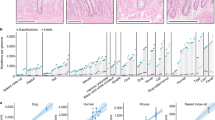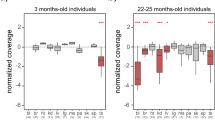Abstract
Somatic mutations have long been considered a possible cause of ageing1,2. To directly study mutational events in organs and tissues of ageing mammals, a transgenic mouse model has been generated that harbours lacZ reporter genes as part of chromosomally integrated plasmids3–5. Using this model, we determined spontaneous mutant frequencies and spectra in mouse liver and brain as a function of age. In the liver, mutant frequencies increased with age from birth to 34 months; in the brain, an increase was observed only between birth and 4–6 months. Molecular characterization of the mutations showed that a substantial portion involved genome rearrangement events, with one breakpoint in a reporter gene and the other in the mouse flanking sequence. In the liver, these genome rearrangements did not increase with age until after 27 months, when they increased rapidly. In brain, the frequency of genome rearrangements was lower than in liver and did not increase with age.
This is a preview of subscription content, access via your institution
Access options
Subscribe to this journal
Receive 12 print issues and online access
$209.00 per year
only $17.42 per issue
Buy this article
- Purchase on Springer Link
- Instant access to full article PDF
Prices may be subject to local taxes which are calculated during checkout
Similar content being viewed by others
References
Failla, G. The aging process and carcinogenesis. Ann. NY Acad. Sci. 71, 1124–1135 (1958).
Szilard, L On the nature of the aging process. Proc. Natl. Acad. Sci. USA 45, 35–45 (1959).
Gossen, J.A., Martus, H-J., Wei, J.Y & Vijg, J. Spontaneous and X-ray-induced deletion mutations in a lacZ plasmid-based transgenic mouse model. Mutat. Res. 331, 89–97 (1995).
Boerrigter, M.E.T.I., Dolle, M.E.T, Martus, H-J., Gossen, J.A & Vijg, J. Plasmid-based transgenic mouse model for studying in vivo mutations. Nature 377, 657–659 (1995).
Dolle, M.E.T., Martus, H-J., Gossen, J.A., Boerrigter, M.E.T.I & Vijg, J. Evaluation of a plasmid-based transgenic mouse model for detecting in vivo mutations. Mutagenesis 11, 111–118 (1996).
Rowe, L.B. et al. Maps from two interspecific backcross DNA panels available as a community genetic mapping resource. Mamm. Genome 5, 253–274 (1994).
Harrison, D.E. & Archer, J.R. Physiological assays for biological age in mice: relationship of collagen, renal function, and longevity. Exp. Aging Res. 9, 245–251 (1983).
Gossen, J.A., Molijn, A.C., Douglas, G.R. & Vijg, J. Application of galactose-sensitive E. coli strains as selective hosts for LacZ-plasmids. Nucleic Adds Res. 20, 3254 (1992).
Gossen, J.A., de Leeuw, W. J.F., Bakker, A.Q. & Vijg, J. DNA sequence analysis of spontaneous mutations at a lacZ transgene integrated on the mouse X-chromosome. Mutagenesis 8, 243–247 (1993).
Bronson, R.T. & Lipman, R.D. Reduction in rate of occurrence of age-related lesions in dietary restricted laboratory mice. Growth, Dev. Aging 55, 169–184 (1991).
Bronson, R.T. in Genetics of Aging II (ed. Harrison, D.E.) 280–358 (Telford, CaldwelI, New Jersey, 1990).
Ames, B.N., Shigenaga, M.K. & Hagen, T.M., Oxidants, antioxidants, and the degenerative diseases of aging. Proc. Natl. Acad. Sci. USA 90, 7915–7922 (1993).
Martin, G.M., Austad, S.N. & Johnson, T.E. Genetic analysis of ageing: role of oxidative damage and environmental stresses. Nature Genet. 13, 25–34 (1996).
Hsie, A.W. et al. Evidence for reactive oxygen species inducing mutations in mammalian cells. Proc. Natl. Acad. Sci. USA 83, 9616–9620 (1986).
Gille, J.J.P., van Berkel, C.G.M. & Joenje, H. Mutagenicity of metabolic oxygen radicals in mammalian cell cultures. Carcinogenesis 15, 2695–2699 (1994).
Mullaart, E., Boerrigter, M.E.T.I., Brouwer, A. & Vijg, J. Age-dependent accumulation of alkali-labile sites in DNA of post-mitotic but not in that of mitotic rat liver cells. Mech. Ageing Dev. 45, 41–49 (1988).
Fraga, C.G., Shigenaga, M.K., Park, J-W., Degan, P. & Ames, B. Oxidative damage to DNA during aging: 8-hydroxy-2′-deoxyguanosine in rat organ DNA and urine. Proc. Natl, acad. Sci. USA 87, 4533–4537 (1990).
Kaneko, T., Tahara, S. & Matsuo, M. Non-linear accumulation of 8-hydroxy-2'-deoxyguanosine, a marker of oxidized DNA damage, during aging. Mutat Res. 316, 277–285 (1996).
Mullaart, E., Boerrigter, M.E.T.I., Boer, G.J. & Vijg, J. Spontaneous DNA breaks in the rat brain during development and ageing. Mutat. Res. 237, 9–15 (1990).
Fukuchi, K., Martin, G.M. & Monnat, R.J., Mutator phenotype of Werner syndrome is characterized by extensive deletions. Proc. Natl. Acad. Sci. USA 86, 5893–5897 (1989).
Yu, C-E et al. Positional cloning of the Werner's syndrome gene. Science 272, 258–262 (1996).
Martin, G.M. & Turker, M.S. in Principles of Geriatric Medicine and Gerontology (eds Hazzard, W.R. et al.) 19–35 (McGraw-Hill, New-York, 1994).
van der Horst, G.T.J et al. Defective transcription-coupled repair in Cockayne syndrome B mice is associated with skin cancer predisposition. Cell 89, 425–435 (1997).
Vijg, J. & Douglas, G.R. in Technologies for Detection of DNA Damage and Mutations, part II(ed. Pfeifer, G.P.) 391–410(Plenum, New-York, 1996).
Author information
Authors and Affiliations
Rights and permissions
About this article
Cite this article
Dollé, M., Giese, H., Hopkins, C. et al. Rapid accumulation of genome rearrangements in liver but not in brain of old mice. Nat Genet 17, 431–434 (1997). https://doi.org/10.1038/ng1297-431
Received:
Accepted:
Issue Date:
DOI: https://doi.org/10.1038/ng1297-431
This article is cited by
-
The 28 + 28 day design is an effective sampling time for analyzing mutant frequencies in rapidly proliferating tissues of MutaMouse animals
Archives of Toxicology (2021)
-
RETRACTED ARTICLE: Aging-associated distinctive DNA methylation changes of LINE-1 retrotransposons in pure cell-free DNA from human blood
Scientific Reports (2020)
-
Burden of unique and low prevalence somatic mutations correlates with cancer survival
Scientific Reports (2019)
-
Expression of progerin does not result in an increased mutation rate
Chromosome Research (2017)
-
Growth conditions that increase or decrease lifespan in Saccharomyces cerevisiae lead to corresponding decreases or increases in rates of interstitial deletions and non-reciprocal translocations
BMC Genetics (2016)



